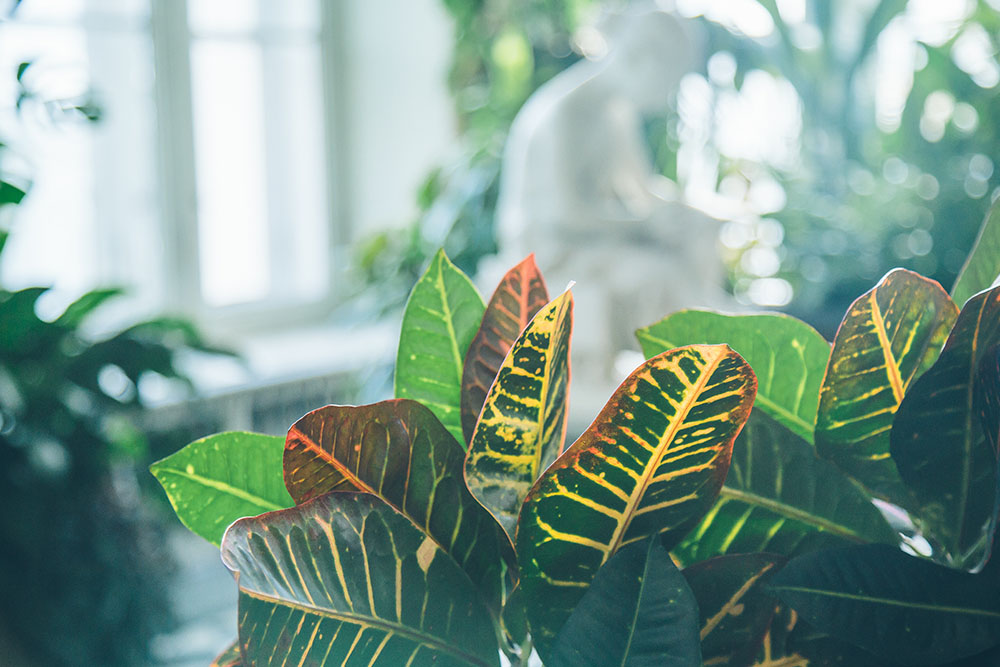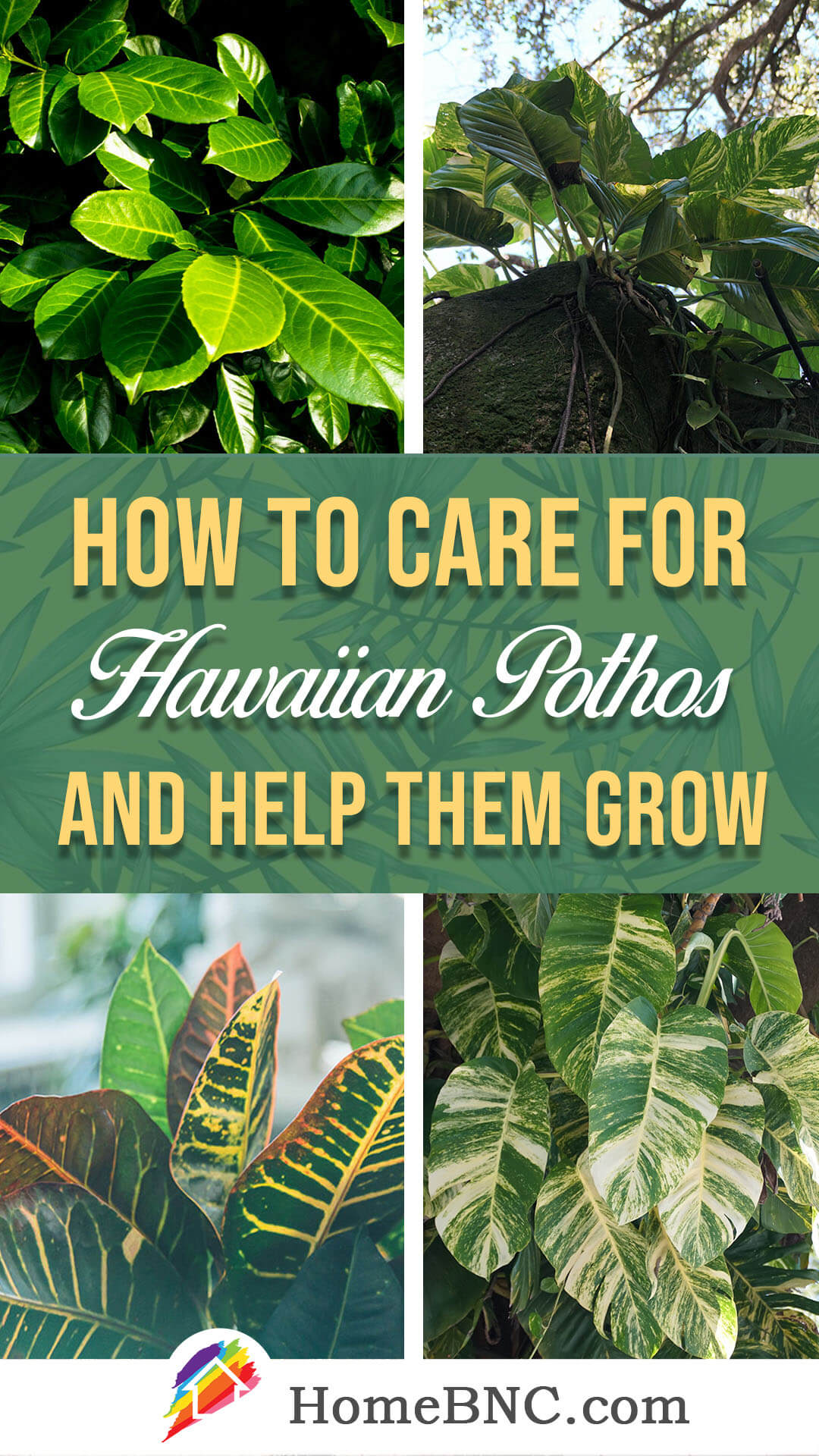If you’re looking for an outstanding addition to your indoor garden, Hawaiian Pothos won’t disappoint. It graces the space with dramatic leaves and makes any space feel tropical. It’s a great beginner’s plant because the care for the Hawaiian Pothos rates among the easiest.
Eye-Catching Hawaiian Pothos
Thanks to originating in French Polynesia, you can almost imagine yourself at a warm beach when you’re sitting by this plant. It has large, vibrant green leaves with a little gloss that catches the light. Ms. Pothos is not a demanding sort. She grows well so long as the water and light are right. A large, dressy leaf for Ms.Pothos measures a foot long.
Because of container planting, the size of your Hawaiian Pothos may vary. If you live in a warmer climate, Pothos can grow outdoors. In this setting, the Hawaiian Pothos grows year-round. The leaves reach 3 feet long, with holes dotting the center rib.
Key Takeaways
- Hawaiian Pothos have a dramatic appeal as an indoor decoration or as an outdoor refinement for your lawn and garden.
- Potting is great for Hawaiian Pothos because you can move them into and out of various levels of light.
- This plant is sturdy, requiring minimal attention, making it great for busy people and beginner gardeners.
8 Insights for Growing Hawaiian Pothos
This plant has fairly low toxicity to people and pets. It would take large amounts for a fatal dose. Children may play with it. Afterward, their mouth, tongue, and lips swell, and they may vomit. So, the best practice is to keep the plant out of children’s reach. Adults may experience skin irritation when working with this plant. An antihistamine cream should ease the discomfort.
In cats and dogs, take care to find ways of keeping them from nibbling. Little pieces cause mouth swelling and can impact breathing. Start looking for top shelves so you can keep the plant well out of their path.
1. Hawaiian Pothos is in the House
Indoors, you’ll need 6-10’ of space for the Pothos. Certain varieties flower or produce berries. They do well in hanging baskets. While it’s unlikely that you have fluorescent lights in your house, this plant tolerates the harsh brightness. Perhaps you can take your Hawaiian Pothos to work day?
Pothos adapts readily to different growing conditions. So if you experience some temperature shifts where you live, your plant should be fine, particularly because you’re keeping it inside. The Hawaiian Pothos grows best in temperatures ranging from 65 to 75 °F but can handle a low of 50 °F. Just keep them away from dry regions of your home.
Periodically, your Hawaiian Pothos benefits from an outdoor jaunt, provided the weather cooperates. Start taking it out for a few hours every morning. Leave them longer every day until the evening temperature won’t harm them. This gives the plant time to adjust. Natural light makes your plant sprightly. Think of the additional beauty the leaves will add to your patio!
Hawaiian Pothos is not a native of Hawaii (oh, no!). Home-sweet-home is French Polynesia. From there, the plant traveled to the islands, where they thrived. It spread like wildfire in the Hawaiian environment.
Hawaiian Pothos Outdoors
While the Hawaiian Pothos is a popular houseplant because it doesn’t mind low light, you can put Pothos into your garden or yard. If you reside in USDA Zones 10-12, you can grow and care for this plant outdoors.
The best way to grow Pothos in the grand outdoors is by using its natural tendency to grow upward. As it extends in a vine-like manner, it adds greenery to tree trunks, trellises, balconies, gazebos, or walls.
A Flower by Any Other Name: You might hold high hopes that your outdoor Hawaiian Pothos will flower. The chances of this, sadly, are very slim, even after a decade of growth. The last time anyone saw a Pathos bloom (in this case, a Golden Pathos) was in the 1960s.
2. Types of Hawaiian Pothos

It’s difficult to sort out various members of the Pothos family because they look remarkably alike. Take the Golden vs. Hawaiian Pothos, for example. The Golden, as the name implies, has a vivid yellow tint vs. the dark green of the Hawaiian, with yellow and white streaks against a dark green background. The golden variety prefers less light than the Hawaiian.
Jade Pothos is deep green, solid all around. It needs more light than golden. The Lime version has vivid yellow-green leaves, while the Marble Queen’s leaves are mossy-green and streaked with white. Finally, to shape up the color scheme, the Tricolor Pothos have variegated leaves with pale white stems.
Hawaiian Pothos Symbolism In some areas, Pothos is a money tree. It’s said to bring whoever owns it improved fortune and wealth.
3. When to Plant the Hawaiian Pothos
Because your Hawaiian Pothos is indoors, you have some flexibility. However, there’s something to be said for following mother nature’s cues. Plant your Pothos at the very beginning of spring. It’s already actively growing, and spring only accentuates that progress.
Tips for Buying a Hawaiian Pothos
There are some sellers advertising plants as Hawaiian Pathos that are NOT. If you’re going out to buy, there are ways to avoid a scam. First and foremost, sellers may offer full plants. A truly “full” Pothos is 13 feet tall (try shipping that by FedEx).
If you can shop in person, look for cuttings with large leaves (9” minimally). They should be broad, firm, and bright green. The size of the leaves indicates healthy growing conditions.
Look for a firm root base. Make an inspection looking for yellow or white splotches that may mean the plant has a disease. And there should be NO mold anywhere to be seen.
You can be a sly shopper and ask the seller to show you pictures of where the plant grew. It should look cultivated, not like a weed.
In lieu of images of the Pothos in their native environment, the next best thing is taking a walk around the garden store. How are the plants organized? Does the space seem well maintained? Are the plants seeming to thrive? Ask questions (do the staff seem informed?). These steps will not always ensure 100 percent satisfaction with your purchase, but they go a long way toward trusting your seller.
4. Container Planting

If you like container planting, you will LOVE the Hawaiian Pothos. When asked, “How do you grow it?” most people respond adamantly, “Use a container.” The Pothos family does best when confined in pots. When let loose on the world, Pothos will run merrily amok. Thankfully, you plan to keep your plant indoors. In this location, the plant stands out in a “housescape” without trying to take over an entire garden.
The best container is one 2 inches wider than the plan’s root mass. Terra cotta is the material of choice. Loose soil increases root growth. If you’re working from a baby rooting, place the rooting in your pot, centralized, and tap potting soil around it. If you have access to it, the soil benefits from the addition of perlite or coco coir, both of which improve drainage capacity.
Your plant should not require repotting for two years.
Support
Avid Hawaiian Pothos growers will tell you to give your plant support, something like a moss pole where it can hold a grip. Without the pole, your plant remains in its juvenile form. The lack of a pole, however, does not hurt the Pothos in any way.
Tip: Besides the soil, pour water and fertilizer on the moss pole, too. This keeps any roots inside the pole from drying out.
5. Hawaiian Pothos Care & Keeping
There are a few simple rules in order to care for Hawaiian Pothos to keep them healthy.
- Fertilizer: Apply a 10-10-10 slow-release granular form in spring.
- Humidity: The best humidity level for the Hawaiian Pothos is between 50-75%. The lowest truly safe humidity level is 40%. If your home is dry, mist your plant regularly.
- Light: This particular plant prefers indirect light. So, you don’t have to go hunting for a south-facing window where you can keep it. If that’s your only choice, keep the plant 6 feet away. An east window is a better choice. Full sun bleaches the Hawaiian Pothos’ leaves or even potentially burns them.
- Soil: The best pH level for Pothos’ soil is 5.5-7. A mix suited to succulents will work for the Hawaiian Pothos.
- Temperature: In that these are “jungle” plants, it’s no surprise they like their space hot. Temperatures below 50 F make them cranky. Frost will kill these plants. Keep them well away from your air conditioner.
- Water: If there’s a choice, lean into dry over wet soils. A foundation that retains water will rot. Do not water your Pothos until the top half of the soil feels dry. Pots that seem heavier than they look may have excess water. Your plant only needs about ⅔ cup of water every 9 days when planted in indirect sunlight.
The pothos gained the nickname of devil’s ivy because of its unique ability to survive. It takes a lot of effort to kill it. As for the moniker of Money Plant, the round flat leaves resemble coins. If you grow it in your home, the plant attracts prosperity.
6. Repotting & Pruning
You won’t have to repot your Hawaiian Pothos until after about 1.5 years (perhaps 2). How will you know the time is right? The plant tells you by having its roots sneaking out of the container drainage holes. When this happens, if you can wait until early spring to repot, it’s best as the plant is in the dormant phase.
In terms of size, don’t increase the pot too much. Look for something that’s no more than 2” in diameter from what you currently have. As with original potting, you have to look for good drain holes in the product.
Put fresh potting soil in the new vessel with enough room for the root ball. Put the plant back in at the same level it was before and give it a good watering.
Nifty fact. Most Hawaiian Pothos need repotting at the same time, they need fertilizing.
Pruning
Pruning keeps your Hawaiian Pothos looking shapely and attractive. Pruning is a way to shape your plant as you wish.
You can get rid of damaged or dead leaves whenever you see them. Trimming just above a leaf node encourages new growth. ALWAYS use a clean pair of pruning shears or knives.
Avoid pruning when your plant is actively growing.
In the jungles of French Polynesia, a mature Hawaiian Pothos looks nothing like your houseplant. It can extend upward of 65 feet. In a good growing season, it will grow as much as 12 inches in one month. Your Pothos is a baby, so it should not grow over 4 feet long and 2 feet wide.
7. Common Pests & Plant Diseases
The most common bugs that “bug” Hawaiian Pothos are the same culprits you see on many indoor plants. Mealybugs and scale are high on the list, followed by aphids and spider mites. If you notice cottony bundles under the Pothos’ leaves, it’s mealy bugs. Stems and leaves with brownish bumps have scales. Spider mites result in yellow dots on the top of the leaves. Aphids are visible light green insects. Treat your Hawaiian Pothos with something like Neem Oil.
Diseases
This is a hardy piece of greenery. The diseases it gets typically occur because of over-watering. When plants sit in wet soil, bacterial leaf spots grow. Fungicide will help with remediation, but you must get your Pothos dried out and find a container with better drainage.
8. Common Hawaiian Pathos Problems

The problems you may experience with the Hawaiian Pothos usually find remedies in growing conditions. When the leaves lose their yellow variegation, move them to an area with less light. Should the leaves droop, check the soil. If it’s dry, add more water; if it’s wet, don’t water so often.
Crispy brown leaves mean the plant is cold. Move it to a warmer space in your house. And, if whole leaves are yellowing, decrease the strength of the fertilizer you use.
8 Particulars for Growing Hawaiian Pothos Successfully
A Hawaiian Pothos makes a fanciful addition to both indoor and outdoor “landscaping.” It is not a “needy” plant. Just remain aware of the water and light levels. You can grow this plant as a potted decoration or a climbing creation. The latter requires vertical space in your home. The Hawaiian Pothos has a moderate growth level, so repotting shouldn’t be necessary for at least a year, if not longer.
Frequently Asked Questions About How to Grow and Care for Hawaiian Pothos
How often should you water a Hawaiian Pothos?
If your plant is in a 5” pot, give it about ⅔ cup of water every 9 days. If the soil still feels damp, wait until 14 days. Remember, the Hawaiian Pothos is very water sensitive. Too much water is the antagonist. If left untreated, your plant may develop mold, or the root ball turns into mush. Yellowing leaves with black stems are sure signs of overwatering.
How do you get big Hawaiian Pothos leaves?
Cow dung in the growing soil is an excellent fertilizer. Add ¼ portion of water-soluble plant food every 4-6 weeks. You can also get a soil test and look at nitrogen levels. If they are too low, your leaves will remain small. Pruning can inspire bushier, thicker leaf growth.
How long does it take for Hawaiian Pothos to grow?
If you are an impatient gardener, the Hawaiian Pothos aims to please. A potted juvenile plant has a fairly rapid growing rate. During the growing season, you can see as much as a foot of new plant appearing. By the end of one year, your Pothos will look quite impressive. If your Pothos lags behind, it’s probably not receiving enough sunlight. While you’re at it, check the water, too.
What temperature is good for Hawaiian Pothos?
The Hawaiian Pothos is definitely a “sunbird.” Being a tropical plant means they like it warm. The Hawaiian Pathos’ happy place is between 70-90 F. When the temperature shifts below or above those points, it hinders the growth of this plant. 50 °F is often the lowest point a Pathos vine can survive. Sometimes, they go into hibernation as a means of survival.
Is 40 degrees too cold for Pothos?
Being subjected to 40 °F weather means the chances of the Hawaiian Pathos’ survival are very low. Mind you, every plant is different. One robust lad might just surprise you with stamina. Overall, if you don’t want your Hawaiian Pathos to die, keep it warm.
Can pothos survive winter?
The answer to this question depends on what your winters are like. In the Southern US, for example, the Pothos may carry on without a problem through their winter period. The North is a whole different story. If you want to be sure before you buy, you can refer to the USDA Zoning Guide. It shows you what plant survives best in different locations. Of course, those are not hard-and-fast borders, but the research is worthy of your attention. There is nothing more disappointing than putting effort into a Pothos and having it die within the first year.



